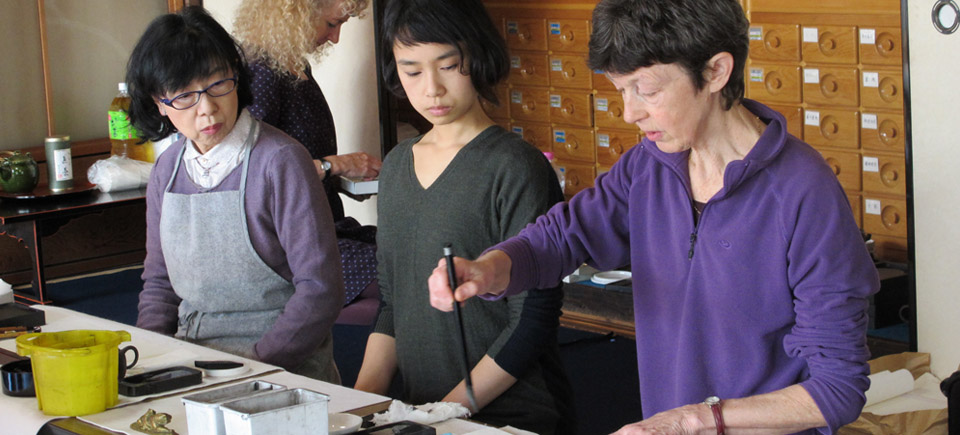Feature
At Play with Brushed Black Ink
When Christine Flint Sato first came to Japan she wanted to learn how to use the East Asian brush. Now she invites others to bring out their inner artist and strike up their own love affair for sumi ink art.
In the 2002 movie Hero, there is a moving scene set in a calligraphy school in the ancient kingdom of Zhao. Under attack from the army of Qin, the teachers and students of the school defiantly continue their calligraphy practice. “Today you will learn the essence of our culture,” says their master, and as a hail of arrows descend on the school, they remain thoroughly absorbed in their art. Their graceful movements are in vivid contrast to the rain of death that falls upon them.
Years ago, inspired by this scene, I took a calligraphy lesson at my local community center. I envisioned myself as a master of ink arts, but I found nothing but frustration. “Copy this Chinese character,” said the teacher, so I brushed a series of clumsy squiggles. The brush would not obey me. The ink came out too thick or thin. I could barely draw a straight line. “Hold the pen like this,“ said the teacher, “And move like this.” In a series of swift fluid motions the simple character 生 for life appeared on the paper. I copied her movements and produced another uniquely original, clumsy squiggle. My teacher was amused. The art of brushed black ink seemed impossible.
Recently I came across a new book by sumi ink artist Christine Flint Sato, The Sumi Workbook. In it she describes how difficult it can be for Western beginners to adapt to the unpredictable nature of the sumi arts, whether in calligraphy or in sumi-e ink painting. Over 30 years of practicing these arts herself, and teaching workshops both in Japan and in the UK, she has developed her own innovative way of helping people to learn it. Her aim is to help others overcome the very frustration I felt, by developing a more playful attitude to the materials themselves. Intrigued, I decided to attend one of her workshops and try these new practice methods for myself.
Our lesson did not begin with Chinese characters.
“I don’t intend to teach shodō calligraphy, or sumi-e in this workshop, ” Christine said. “It’s more of an encounter with sumi, to see how it reacts with the page…” Then we did stretches, for Christine says that relaxation is key. Having loosened up, we began with the simplest of abstractions; the line. Take a breath, she told us and then as you breath out, let the brush move across the page: “The breath tells us how long to draw the line.” And so the whole room fell into a quiet meditative focus, as each student drew repeated lines across the page. Christine moved among us offering tips, “Don’t grip the brush too tightly. Relax with the ink.”
Next, we moved onto circles, then squares, then triangles and dots. By focusing on these simple abstract shapes, we were able to familiarize ourselves with the spring of the brush held in different positions and with different pressures and speeds. When we had fully practiced these basic shapes in different shades of ink, we were given free rein to play with more complex designs and combinations. All the while we were encouraged; “Let the breath be the brush’s guide”. Christine told me that this method of using the breath was something she intuitively came up with. “I wanted to relax into it and get away from the pressure of doing it right.”
At the end of the workshop, we came together to share our work and thoughts on the day. Everybody had enjoyed themselves and I was impressed with the work the other members produced. For myself, though I did not produce any masterpieces, my old frustrations slipped away. Simply playing with sumi is fun.
Christine Flint Sato gives workshops in Osaka and Nara. To learn more, visit her website sumiwork.com/work.html. The Sumi Workbook is available from amazon.co.jp














